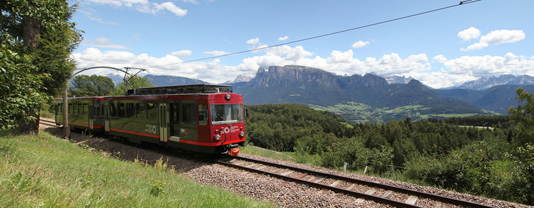The Alpine railways are renowned throughout the world for their beauty and the technical audacity of their routes. The most famous are undoubtedly inSwitzerlandandAustria, butItalyalso boasts some truly delightful little railways. This is the case of the Renon Railway which runs for approx. 7 km on the plateau of the same name, above the city ofBolzano. We are in the far north ofItaly, in South Tyrol, eighty-odd kilometres fromAustria, along the valley covered by the Brenner international railway which linksVeronawithInnsbruck. What makes this little railway so special, apart from the magnificent Alpine scenery it runs through? Essentially two things: the undertaking to preserve the infrastructure and historical vehicles of the railway with almost manic precision, while adapting them to current transport and safety standards, and the decision to include the railway in the local public transport system, thereby maintaining its original function, rather than transforming it into a “tourist ride”. Of course, tourists do take it by storm all year round, but they share the trains with the commuters and students who travel daily through the plateau or who are bound – thanks to its integrated cableway – for the city ofBolzanoin the valley below. But to discover the secrets of this little railway, which celebrated its centenary in 2007, we met with Markus Untermarzoner, the Chairman of the “Comitato della Ferrovia del Renon” (Renon Railway Board).
Railway Engineering: You are the Chairman of the “Comitato della Ferrovia del Renon” : what are the responsibilities and activities of the Board that you direct? Markus Untermarzoner: The Board is a committee of the Municipality of Renon. Our main responsibility is the preservation of the Renon Railway and all that this entails, including infrastructures, such as the stations, stops, rolling stock and all the historical routes. We do, of course, have our say on safety issues and on any choices to be made regarding the public transport service. The Board was founded in the 1970s to combat the idea – on the cards at that time – to permanently dismantle the railway and replace it with a bus service.
Full article is available only for registered users.
Click the link below to download pdf version of Railway Engineering
